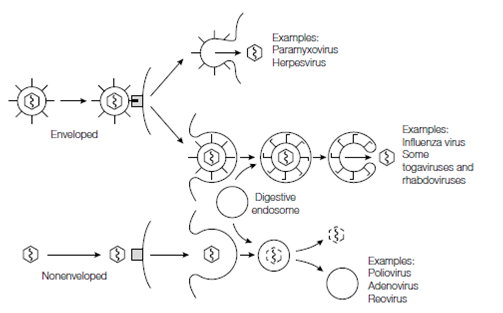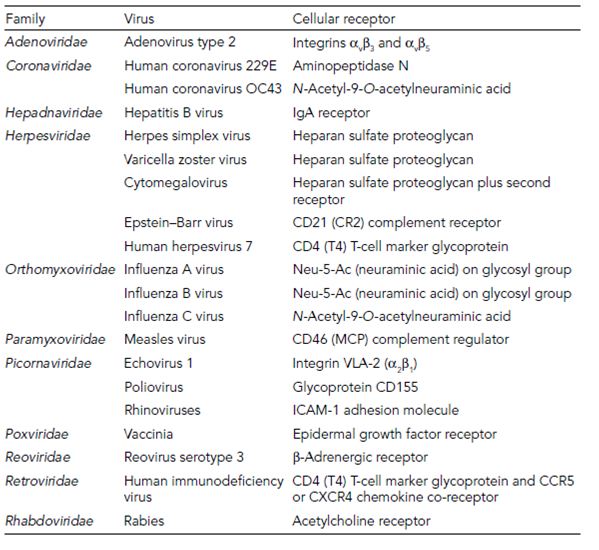Attachment, penetration, and uncoating
Attachment is mediated by the specific interaction between viral attachment proteins within the capsid or envelope and a receptor on the plasma membrane of the cell). Importantly, the presence of the receptor determines the cell tropism and species tropism of a virus. Receptors clearly have cellular functions other than providing a binding site for viruses, but have nonetheless been paramount in affecting virus evolution. Table 1 list examples of specific receptor sites available on host cells for attach- ment by viruses. HSV binds to cells through interaction of several envelope glycoproteins with various molecules including heparan sulfates, proteoglycans, and others. Two gly- coproteins, gB and gC, mediate the initial receptor binding step then a third, gD, makes the critical, irreversible binding that commits the virus to infecting the cell. The polio- virus attachment protein (the capsid protein VP1) interacts with CD155, a member of the immunoglobulin (Ig) protein superfamily found only on many cells within humans and primates. HIV also has a limited cell tropism as a result of its attachment specificity. The attachment protein, the major envelope glycoprotein (gp120), attaches to the CD4 receptor found predominantly on human T4 lymphocyte lineages. Two further cell sur- face molecules, CCR5 and CXCR4, have a role in HIV attachment as co-receptors, and susceptible cells (macrophages and helper T lymphocytes, respectively) have one or the other in addition to CD4. The receptor bound by the HPV attachment protein, L1, is as yet unknown, but is presumably limited to cells of stratified epithelia. By contrast, the influenza virus can infect a broad range of cells within the body as its attachment pro- tein hemagglutinin (HA) binds to N-acetylneuraminic (sialic) acid, a small carbohydrate group found on plasma membrane proteins of many cell types.
Attachment is closely followed by penetration of the virus into the cell and (usually) uncoating, where the viral genomic information is released from the capsid into the cyto- plasm or nucleus. The naked capsids of poliovirus and HPV enter cells as a result of endocytosis, triggered by binding of the virion attachment protein and plasma membrane receptor. The plasma membrane invaginates locally to engulf the capsid, forming a vacuole that transports the capsid into the cytoplasm. Fusion with a cellular lysosome lowers the pH of the vacuole, resulting in alterations of the virion structural proteins, opening a pore in the capsid that allows escape of the viral genome into the cytoplasm. While the poliovirus genome is immediately trans- lated by ribosomes within the cytoplasm, the HPV genome is trafficked to the nucleus

Figure: Methods of virus entry. Adapted from Harper DR (2011) Viruses: Biology, Applications and Control. Garland Science.
Table 1. Examples of receptors for viruses that infect humans

with the assistance of L2, a minor structural protein from the disrupted cap- sid. HSV and HIV penetrate the cell by fusion of their viral envelope with the plasma membrane, releasing the capsid into the cytoplasm. As well as the capsid, tegument proteins of HSV also enter the cell, and some interact with cellular microtubules to deliver the capsid to the nucleus, before uncoating of the HSV genome. Uniquely, the HIV capsid remains largely intact and genome replication begins within the framework of this structure. Influenza virus shows a com- bination of these penetration strategies; endocytosis of the virion is followed by release of the (multiple) nucleocapsids into the cytoplasm by fusion of the envelope and vacuole membranes, mediated by the viral HA protein. Unusually for an RNA virus, the influenza virus genome is replicated in the cell nucleus, requiring the transport of all the nucleocapsids from the site of vacuole fusion to the nucleus.